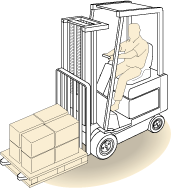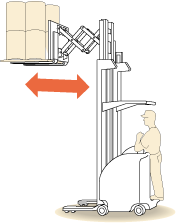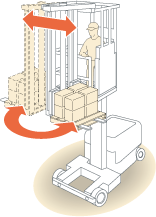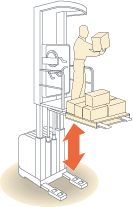Lift truck basicsBy Corinne Kator, Associate Editor An introduction to the design, application and cost of counte...
Lift truck basics
By Corinne Kator, Associate Editor
An introduction to the design, application and cost of counterbalanced lift trucks, narrow-aisle lift trucks and pallet jacks.
May 1, 2007
The first lift trucks, introduced in the 1920s, were simple pieces of motorized equipment designed to move pallet loads from point A to point B. Today, sophisticated lift trucks are available in a combination of designs, weight capacities and lifting heights and with a variety of safety and ergonomic features.
Perhaps the only universal characteristics of today’s diverse selection of lift trucks are the forks used to lift loads and the tires used to move them. (And even lift truck tires come in two varieties: cushion and pneumatic. Cushion tires are made of solid rubber and are best for indoor applications. Pneumatic tires, which are inflated with compressed air, are more expensive and preferred for outdoor work.)
This article provides an introduction to the design, application and cost of several types of lift trucks:
Counterbalanced lift trucks
Internal combustion trucks
Electric trucks
Narrow-aisle lift trucks
Reach trucks
Turret trucks
Orderpickers
Low lift pallet trucks (a.k.a. pallet jacks)
COUNTERBALANCED TRUCKS
The most common type of lift truck, also known as a forklift, is the counterbalanced, sit-down truck. A weight located in the rear of one of these trucks counterbalances the weight of the load, ensuring the truck doesn’t tip forward.
A typical counterbalanced lift truck has:
a capacity of 5,000 pounds,
a lifting height of about 16 feet, and
comes outfitted with lights, backup alarms and other safety features.
Counterbalanced trucks are powered either by internal combustion engines or electric motors.
Internal combustion counterbalanced lift trucks
More than 60% of the counterbalanced lift trucks sold in North America during 2006 were of the internal combustion type, according to James Malvaso, president of the Industrial Truck Association (ITA) and CEO of Raymond Corp. This includes trucks for both indoor and outdoor use. The percentage of internal combustion lift trucks used for indoor warehousing applications, he says, is not nearly as large.
Internal combustion trucks run on a variety of fuels, including gasoline, diesel, liquid propane gas (LPG) and compressed natural gas (CNG). LPG is the most common fuel for indoor trucks. Larger lift trucks for outdoor use are typically gasoline- or diesel-powered.
Compared to electric trucks, internal combustion trucks are quicker and easier to refuel, but they must be refueled multiple times per shift. While they also produce noise and air-polluting emissions, the federal Environmental Protection Agency (EPA) as well as the California Air Resources Board have set standards that limit emissions.
According to “Rules of Thumb,” a pricing guide published by consulting firm Gross & Associates, a counterbalanced LPG truck with a 5,000-pound capacity costs roughly $19,000 to $24,000.
The ITA classifies internal combustion counterbalanced lift trucks with cushion tires as Class 4 trucks and those with pneumatic tires as Class 5.
Electric counterbalanced lift trucks
Electric trucks get their power from large, heavy lead-acid batteries, which provide much of their counterweight. These trucks are only suitable for indoor use.
While they cost more than internal combustion trucks, electric trucks are less expensive to operate, says Malvaso, due to lower fuel and maintenance costs. “Rules of Thumb” lists an electric counterbalanced truck with a 5,000-pound capacity at $25,000 to $30,000, including a battery and charger.
Electric trucks are quiet, produce no emissions and can usually run a full eight-hour shift on one battery charge. Removing, recharging and reloading batteries—which typically weigh around 3,000 pounds—can be cumbersome and time consuming, however, and traditionally require a dedicated space for battery handling. Newer fast charging technologies, however, are beginning to change that paradigm.
Electric counterbalanced trucks are classified as Class 1 lift trucks by the ITA. Class 1 also includes stand-up counterbalanced trucks and other electric trucks built for general use.
NARROW-AISLE LIFT TRUCKS
The ITA’s Class 2 includes a variety of electric lift trucks built for use in narrow aisles.
At 12 feet wide, standard storage aisles allow a counterbalanced lift truck to turn in the aisle and put away a load. Narrow aisles are typically only 8 feet wide—and very narrow aisles are only 5.5 to 6 feet wide—requiring specialized lift trucks that can put away loads without turning or that are small enough to make tight turns.
Three of the most common narrow-aisle trucks are reach trucks, turret trucks and orderpickers.
Narrow-aisle reach trucks
Reach trucks are the original narrow-aisle lift truck.
These trucks are small enough to turn in narrow aisles because they don’t need a large counterweight. Instead, outrigger arms extend in front of the trucks to provide stability. The outrigger arms, however, can prevent the trucks, depending on storage configuration, from getting close enough to the storage rack to deposit and retrieve loads. To overcome this, a reach truck is designed with a telescoping mechanism—called a pantograph—that allows the forks to reach into storage locations.
Prices for 4,000-pound capacity narrow-aisle reach trucks range from $25,000 to $32,000, according to “Rules of Thumb.” Operator training for reach trucks may take longer than for other trucks because of the complexity of the controls.
Turret trucks
The lift truck often chosen for work in very narrow aisles is the turret truck. These trucks have pivoting forks that turn 90 degrees on either side and traverse from side to side.
To put away a load, an operator drives down the aisle with the load facing forward and then stops at the designated storage location. The forks pivot to the appropriate side and lift the load to the desired height. Then the forks traverse to their full extension, depositing the load. The forks return to their original position before forward travel resumes.
Turret trucks can be completely operator guided or can run on a wire guidance system—an attractive option in very narrow aisles. In man-up trucks, the operator compartment rises with the load. In man-down trucks, operators remain at floor level.
According to “Rules of Thumb,” a wire guided, man-up turret truck with a 4,000-pound capacity costs between $65,000 and $95,000.
Orderpickers
While reach trucks and turret trucks are used for storing and retrieving pallet loads, orderpickers are used for handling individual items or cases. An orderpicker, also known as a stockpicker or an order selector, lifts the operator on a platform along with the forks. The operator picks items from bulk storage locations and places them directly onto a pallet on the forks of the truck.
Orderpickers can safely move forward while in an elevated position. They can be completely operator-guided or can run on wire guidance systems. “Rules of Thumb” lists a 3,000-pound capacity orderpicker at $19,000 to $28,000 and suggests adding $5,000 for wire guidance.
LOW LIFT PALLET TRUCKS (PALLET JACKS)
The simplest and least expensive lift trucks are non-powered pallet trucks, also known as hand pallet trucks or hand pallet jacks.
Non-powered pallet trucks use a lifting device—usually hydraulic—to raise pallets just a few inches off the floor. Operators then grab the truck’s handle and pull the load behind them.
Non-powered pallet trucks can cost as little as $500. Stainless steel pallet trucks required for food handling can cost up to $3,000, according to “Rules of Thumb.”
Electric-powered pallet trucks are also available. These trucks are:
easy to maneuver,
relatively inexpensive, and
available with forks long enough to accommodate two or three pallet loads.
Powered pallet trucks come in two versions, known as “walkies” and “riders.” The walkie is designed for the operator to walk along with the truck, while the rider has a platform on which the operator can stand. These trucks are often used in warehouses for order picking, with operators stacking cartons on pallets as they work their way down the picking aisles.
According to “Rules of Thumb,” powered pallet trucks range in price from $4,500 for a 4,000-pound capacity walkie to $13,000 for an 8,000-pound capacity rider.
Powered and non-powered pallet trucks are included in ITA’s Class 3.











 粤公网安备 44010602003952号
粤公网安备 44010602003952号